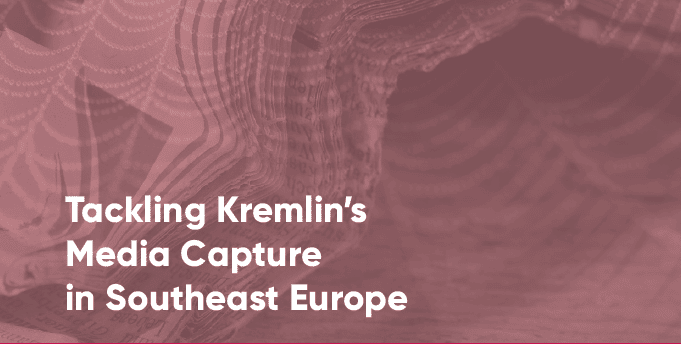In addition to military invasions and threats, Russia exerts its influence in neighboring countries and regions through propaganda and misinformation. Southeast Europe is among Russia’s main targets. These efforts are detailed in the Center for the Study of Democracy’s groundbreaking report “Tackling Kremlin’s Media Capture in Southeast Europe” by Rumena Filipova, Alexander Gerganov and Martin Vladimirov. (Excerpted by Mark Worth; reprinted with permission.)
Southeast Europe is a civilizational crossroads and geopolitical battleground between the great powers of the past. Its emerging democracies represent one of the most vulnerable regions in Europe to foreign malign influence. Foreign authoritarian states, primarily Russia, have intensified their sharp-power efforts to derail faith in liberal democracy and present authoritarianism as a more viable political alternative for the region.
Moscow remains the most disruptive force for Southeast European democratic development prospects, seeking to deploy the full array of its power mix. The exercise of Russian influence is shaped by two defining characteristics of the political regime in Moscow – autocracy and corruption. The resulting state capture power cements the Kremlin’s grip on Russian society and allows it to pursue its revisionist foreign policy.
The Kremlin’s aim is to win the hearts and minds of Balkan publics toward undermining the attractiveness of the Western liberal democratic model of governance. Russia has sown distrust in regional media audiences about their countries’ Euro-Atlantic path by prominently disseminating anti-EU/NATO narratives. Southeast Europe has been a successful testing ground for Russia’s global disinformation and propaganda strategy promoting the Kremlin’s vision of the international order.
Opaque and corruptive local business-political networks have enabled Russian media influence in Southeast Europe by maintaining political, economic and ideological ties to pro-Russian groups and interests. As a result, the Kremlin has been able to gain a foothold in Balkan media spheres, intimidating journalistic independence and disseminating its preferred narratives.
Russia’s media capture is having a malign impact on good governance and democratic development in Albania, Bosnia and Herzegovina, Bulgaria, Croatia, Kosovo, Montenegro, North Macedonia and Serbia. Audiences in Southeast Europe are susceptible to malign Russian influence due to remaining East-West cultural ambivalences and a disenchantment with the process of democratic transition. One powerful channel, utilized by Russian propaganda, has been the exploitation of the low trust in media across Southeast Europe.
Conspiracies, Epithets and Sarcasm
Russian-owned outlets make use of Russia-related cognitive capture by blanketing the local info space with pro-Kremlin propaganda. Outlets directly owned by Russia – including local-language editions of Russia Beyond, Sputnik and News Front – are distinguished by the most straightforward and aggressive promotion of Kremlin propaganda. On topics important to the Kremlin, Russian-owned outlets produce on average four times more articles per month than locally-owned ones.
Russia’s media influence is enabled by local political leaders who benefit from Russian political and economic support, and in return parrot the Kremlin’s messages publicly. Official statements from the Kremlin, its foreign ministry and powerful Russian oligarchs with business ties in the region are taken up by their local political allies, thus intimidating the media into self-censorship.
Pro-Russian media relies on a sensationalist style of narration that trumps any evidence-based messages appealing to local nationalistic emotions and stereotypes. Russia’s propagandist techniques include bombastic headlines, evaluative epithets, sarcasm, binary distinctions that present the world in black-and-white terms, moral opprobrium that evokes indignation of supposed Western transgressions, exaggeration of Russia’s strengths and Western weaknesses, and promotion of conspiracies and impending threats.
Articles with at least one of these six words and phrases – Russian army, Crimea, Putin, Lavrov, Russia and NATO – account for 20-90 percent of all content produced by four major Russia-owned outlets. This focus on key words and messages fits well with the long tradition of international propaganda that a lie repeated a thousand times becomes the truth.
Media capture pierces, penetrates and perforates the political and informational environments. Authoritarian states apply informational tools – linked to censorship, disinformation proxy cultural institutes – to sway public opinion and ultimately subvert democracy.
